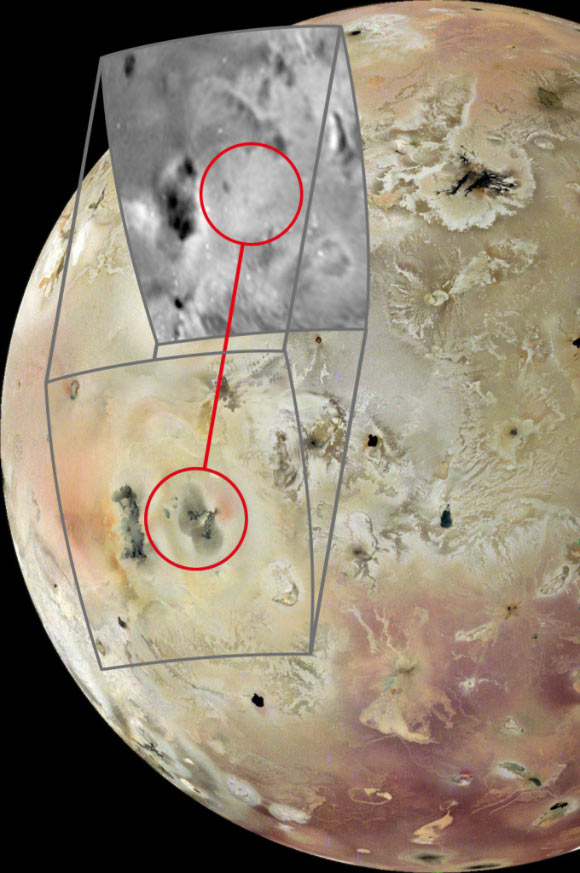
Using images from the JunoCam instrument aboard NASA’s Juno spacecraft, planetary scientists have spotted a fresh volcano with multiple lava flows and volcanic deposits covering an area about 180 x 180 km.

A comparison of the JunoCam image from February 2024 with Galileo spacecraft imagery of the same area in November 1997 (grayscale insert) reveals a new volcanic feature on the surface of Io. Image credit: NASA / JPL-Caltech / SwRI / MSSS / Europlanet.
Slightly larger than Earth’s Moon, Io is the most volcanically active body in the Solar System.
This moon is the innermost of Jupiter’s Galilean moons, which in addition to Io include Europa, Ganymede and Callisto.
Io’s volcanic activity is the result of tidal heating from friction generated within the moon’s interior as it is pulled between Jupiter and its neighboring moons of Europa and Ganymede.
The newly-discovered volcano is located just south of Io’s equator.
Although the moon is covered with active volcanoes, images taken during NASA’s Galileo mission in 1997 did not see a volcano is in this particular region — just a featureless surface.
“Our recent JunoCam images show many changes on Io, including this large, complicated volcanic feature that appears to have formed from nothing since 1997,” said Michael Ravine, advanced projects manager at Malin Space Science Systems, Inc.
The eastern side of the new volcano is stained a diffuse red from sulfur that has been vented by the volcano into space and fallen back onto Io’s surface.
On the western side, two dark streams of lava have erupted, each running for about a hundred km.
At the farthest point of the flows, where the lava has pooled, the heat has caused the frozen material on the surface to vaporize, generating two overlapping grey circular deposits.
The best JunoCam image of this feature, east of an existing volcano called Kanehekili, was taken on February 3, 2024, from a distance of 2,530 km.
This encounter was one of three recent flybys of Io in 2023 and 2024, during which JunoCam acquired around 20 close-up visible color images.
JunoCam observed a total of nine plumes associated with active volcanic features on the moon, as well as other changes, such as new lava flows and other surface deposits.
“JunoCam images are created by people from all walks of life, providing a way for anyone to join our science team and share in the excitement of space exploration,” said Juno principal investigator Dr. Scott Bolton, a researcher at Southwest Research Institute.
_____
Michael Ravine et al. 2024. Results from recent close-up imaging of Io by JunoCam (perijoves 57, 58 and 60). EPSC Abstracts 17, EPSC2024-731; doi: 10.5194/epsc2024-731
 Print
Print


